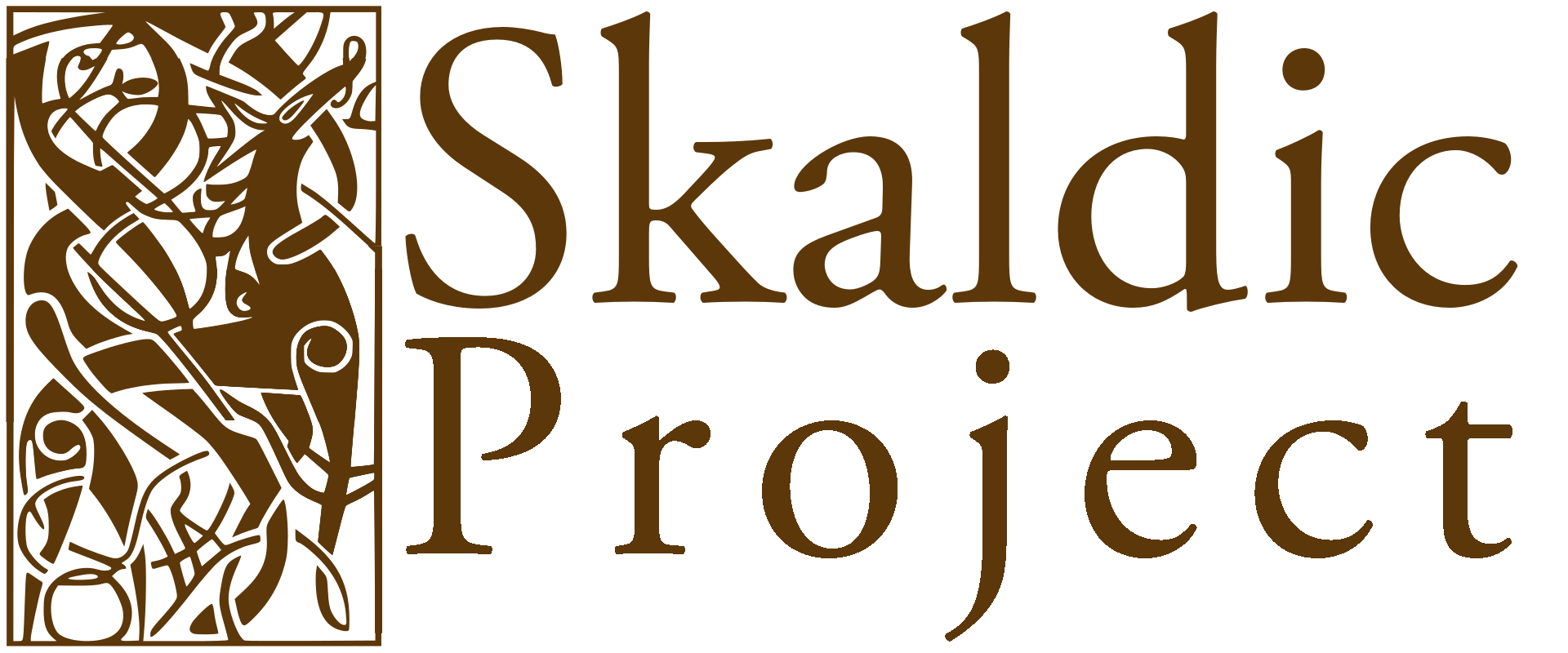GunnLeif Merl I 53VIII
Russell Poole (ed.) 2017, ‘Breta saga 121 (Gunnlaugr Leifsson, Merlínusspá I 53)’ in Margaret Clunies Ross (ed.), Poetry in fornaldarsögur. Skaldic Poetry of the Scandinavian Middle Ages 8. Turnhout: Brepols, p. 90.
Verðr ‘will be’
(not checked:)
1. verða (verb): become, be
meinliga ‘with ill intent’
(not checked:)
meinliga (adv.): [painfully]
mæki ‘The sword’
(not checked:)
mækir (noun m.): sword
brugðit ‘drawn’
(not checked:)
bregða (verb; °bregðr/brigðr; brá, brugðu; brugðinn/brogðinn): pull, jerk, break; change
sék ‘I see’
(not checked:)
2. sjá (verb): see
blóði ‘blood’
(not checked:)
blóð (noun n.; °-s): blood
ben ‘the wound’
(not checked:)
1. ben (noun f.; °-jar, dat. -; -jar , gen. -a(var. EiðKrC 402¹³: AM 77 4° D)): wound
blása ‘spurt with’
(not checked:)
2. blása (verb; °blǽss; blés, blésu; blásinn): blow
móður ‘the mother’s’
(not checked:)
móðir (noun f.): mother
líðr ‘will come’
(not checked:)
1. líða (verb): move, glide
mart ‘Much’
(not checked:)
2. margr (adj.; °-an): many
hǫfugt ‘hardship’
(not checked:)
hǫfugr (adj.; °acc. hǫfgan, compar. hǫfgari): heavy, difficult
of ‘over’
(not checked:)
3. of (prep.): around, from; too
lýða ‘of men’
(not checked:)
lýðr (noun m.; °-s, dat. -; -ir): one of the people
notes
[6] lýða ‘of men’: Skj A has liða, probably by dittography, for clear ‘lyda’ in Hb (cf. Bret 1848-9 and Skj B).
kyn ‘the race’
(not checked:)
1. kyn (noun n.; °-s; -): kin
Rýðr ‘will redden’
(not checked:)
rjóða (verb): to redden
varðar ‘of the woman’
(not checked:)
vǫrð (noun f.): woman
blóð ‘The blood’
(not checked:)
blóð (noun n.; °-s): blood
Venedócíam ‘Venedotia’
(not checked:)
Venedócía (noun f.)
notes
[8] Venedócíam ‘Venedotia’: Gunnlaugr uses the Latin first declension acc. sg. form. Merl 2012 states that no such name exists in the British Isles and looks to Brittany for referents, but see Note to [All].
ok ‘and’
(not checked:)
3. ok (conj.): and, but; also
síðan ‘then’
(not checked:)
síðan (adv.): later, then
sex ‘six’
(not checked:)
sex (num. cardinal): six
snarpir ‘bold’
(not checked:)
snarpr (adj.): sharp, keen
lifra ‘brothers’
(not checked:)
lifri (noun m.): °(heiti; for bror)
kynsmenn ‘kinsmen’
(not checked:)
kynsmaðr (noun m.)
drepa ‘will slay’
(not checked:)
drepa (verb; °drepr; drap, drápu; drepinn): kill, strike
Kórínéus ‘of Corineus’
(not checked:)
Kóríneus (noun m.)
Interactive view: tap on words in the text for notes and glosses
Cf. DGB 113 (Reeve and Wright 2007, 147.86-149.87; cf. Wright 1988, 104, prophecy 11): Venedocia rubebit materno sanguine, et domus Corinei sex fratres interficiet ‘Venedotia will run red with a mother’s blood, and the house of Corineus kill six brothers’ (Reeve and Wright 2007, 146, 148). The historical status of this prophecy is difficult to assess. The first clause of the prophecy possibly extrapolates Geoffrey’s awareness of growing unrest against Henry I in Wales (Poole 1955, 290-1; cf. Curley 1982, 223) into the immediate future. The Lat. Venedocia corresponds to Welsh Gwynedd, the kingdom in North Wales. The mention of the house of Corineus, i.e. the successors of the legendary first ruler of Cornwall (cf. DGB I: Reeve and Wright 2007, 28-9) in the second clause of the prophecy might then personify Cornish involvement in this imagined conflict. But confused records exist concerning an atrocity in Cornwall, committed against Normans and datable to some time between 1100 and 1129 (Padel 1984, 20-7), that matches the account and hence gives the prophecy historic status. — [3-4]: To judge by their subject-matter, these lines may have originally belonged after ll. 5-6 and have come in here by way of anticipation. Previous eds signal the difficulty by placing ll. 5-6 in parentheses. — [9-12]: The word order is somewhat convoluted, since sex ‘six’ must be taken, for sense and match with Geoffrey’s text, with lifra ‘brothers’, not snarpir kynsmenn ‘bold kinsmen’ (contrast Bret 1848‑9).
Stanza/chapter/text segment
Use the buttons at the top of the page to navigate between stanzas in a poem.
Information tab
- text: if the stanza has been published, the edited text of the stanza and translation are here; if it hasn't been published an old edition (usually Skj) is given for reference
- sources: a list of the manuscripts or inscriptions containing this stanza, with page and line references and links (eye button) to images where available, and transcription where available
- readings: a list of variant manuscript readings of words in the main text
- editions and texts: a list of editions of the stanza with links to the bibliography; and a list of prose works in which the stanza occurs, allowing you to navigate within the prose context
- notes and context: notes not linked to individual words are given here, along with the account of the prose context for the stanza, where relevant
Interactive tab
The text and translation are given here, with buttons to toggle whether the text is shown in the verse order or prose word order. Clicking on indiviudal words gives dictionary links, variant readings, kennings and notes, where relevant.
Full text tab
This is the text of the edition in a similar format to how the edition appears in the printed volumes.
Chapter/text segment
This view is also used for chapters and other text segments. Not all the headings shown are relevant to such sections.
